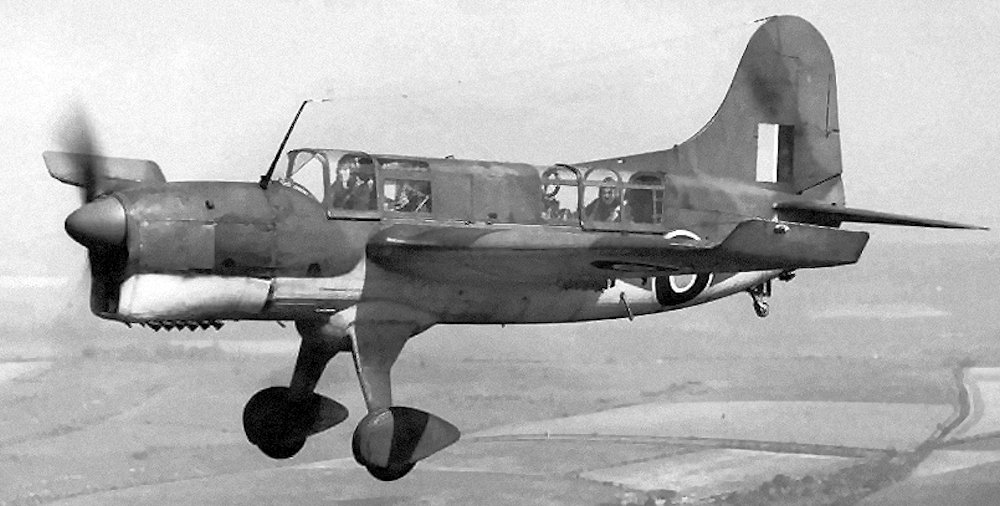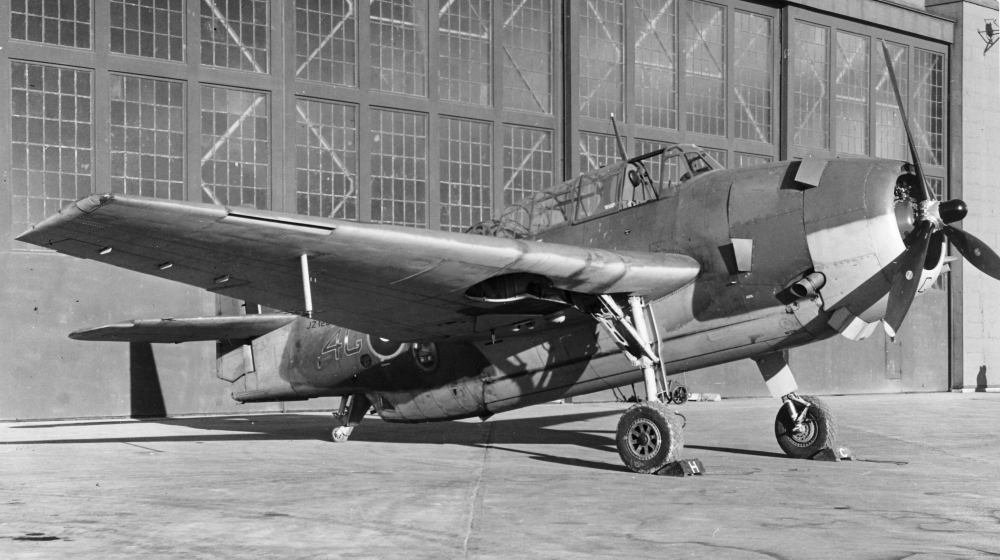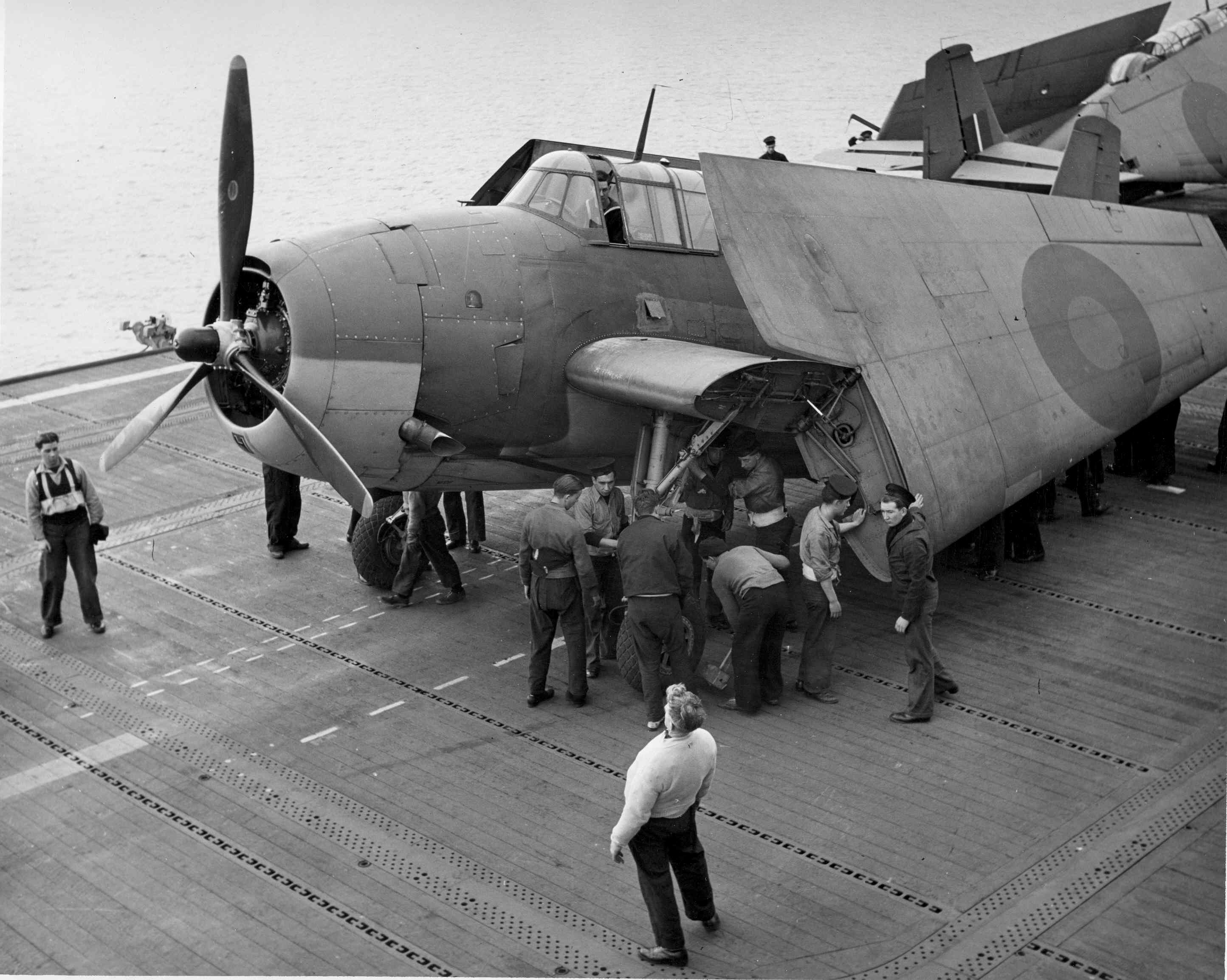



Twenty-six aircrew, 15 pilots and 11 observers, were appointed to 850 squadron which was due to form at US Naval Air Station Quonset Point, Rhode Island on January 1st 1943 for duty as a long-range reconnaissance squadron. Squadron equipment was to be 12 Curtiss SO3C Seamew. Lt. J. H. Stenning RN was appointed to command the squadron but the formation was cancelled and the squadron was officially disbanded on January 31st.

The Curtiss SO3C Seamew in RN service. The type entered service only in second-line and training roles.
The Squadron was formed in the United Sates on September 1st 1943 at the US Naval Air Station Squantum, Massachusetts under the command of Lt Cdr (A) (P) A. P. Boddani-Whetham, DSC. RN. The squadron was issued with twelve Tarpon Is.[1] The flying personnel were organised to form thirteen crews, twelve being assigned their own aircraft with one a spare crew.

The Grumman Avenger Mk.1 - initially known as the 'Tarpon' in RN service. This is '4C' of 850 squadron ashore at RCAF Sea Island.
Few of the squadron officers had previous squadron experience, the others were pilots who had just completed their training with the US Navy at Pensacola and Fort Lauderdale, and observers who had recently finished their training at RNAS Piarco, Trinidad. The squadron complement also included 13 Telegraphist-Air-Gunners and a ground staff of 107 Petty Officers and ratings.
After familiarisation with the aircraft and equipment the squadron began training in earnest to prepare for active service. The 12-week work-up period embraced all the many aspects of the work of torpedo bomber reconnaissance squadrons and included navigation exercises, low flying, formation flying and combat tactics, torpedo and depth charge attack techniques.
There were six flying incidents during their time at Squantum; the first was on October 19th when Sub-Lt J. H. Day RNVR taxying in JZ107 at night was run intro by JZ103; on the 23rd FN945 flown by Sub-Lt G. O. Hunkin RNVR was hit by a seagull in flight which smashed through a Perspex panel in the cockpit; on the 25th The undercarriage of JZ105, flown by Sub-Lt S. Stanbrook, collapsed on landing. The squadron undertook a period of Deck Landing Training (DLT) with the training carrier USS CHARGER from November 9th and two aircraft suffered crashes on landing; Sub-Lt A. Dickson RNVR in FN919 slewed to port on touchdown and ran into the catwalk; on the 12th Sub-Lt D. R. Whitehead in JZ113 suffered an arrester hook failure, it broke off on the arrester wire and the starboard wingtip hit the island and the aircraft crashed. Tragedy struck the squadron on November 18th when JZ169 dived into the sea while on night flying exercises killing the crew, Sub-Lt A. Dickson RNVR, Lt. R. Stainer and leading Airman T. C. R. Williams.
At the end of the work-up the squadron prepared for a cross-country trip, Squantum to Vancouver, British Columbia, on the west coast of Canada, in preparation for embarking on an Escort Carrier. The aircraft flew to Vancouver following the normal aircraft ferry route, which was south to the Mexican border, through the Rocky Mountains and then up the west coast of America.
A ground party travelled by train with the squadron stores. The flight to Vancouver, which started on December 1st 1943, was done in several legs; Squantum, Massachusetts to Lynchburg, Virginia; Lynchburg to Shreveport, Louisiana; Shreveport to El Paso, Texas; El Paso to Tucson, Arizona; Tucson to Los Angeles, California; Los Angeles to Redding, California; Redding, to Portland, Oregon; Portland to Vancouver, arriving at RCAF airfield at Sea Island on December 12th.
The squadron stayed ashore at the RCAF airfield at Sea Island for about five weeks, during which time the aircraft were repaired from the ravages of the flight from Squantum and the crews prepared to join the escort carrier HMS EMPRESS, which was in port at Vancouver.
EMPRESS was a new American built CVE (escort aircraft carrier) which was in the hands of the Burrard Dry-Dock Co Ltd of North Vancouver to receive the modification and alterations necessary to bring her up to Admiralty standards. Work had commenced on August 30th and the works were completed in a total of 99 days, being finished on December 6th. On December 9th she left the LaPointe Pier site and was moved to the Burrards terminal where she was to load stores and prepare for sea. On December 27th EMPRESS, was moved to a mooring in the pool before finally emerging from the Burrards works on January 13th 1944 when she was moored in the harbour inlet.
The squadron continued training while ashore at Sea Island, and operated with EMPRESS, for the first time on January 20th 1944, conducting a period of deck landing training while the ship steamed in the Georgia Strait, between Vancouver Island and the Pacific coast of British Columbia. Five days later the squadron was to fly out to HMS NABOB, another CVE that had just completed the work at Burrards, for a day of flight operations to put the ship through its paces. The rendezvous was again in the Georgia Strait, but while steaming at speed into wind to receive aircraft NABOB ran aground on an uncharted sand bar and stuck fast. None of the aircraft had landed on but they flew over the stranded ship until her sister CVE RANEE arrived to offer assistance. NABOB was aground for three days before tugs could free her.
EMPRESS departed from Vancouver on February 17th 1944 and the squadron flew out to join her for passage to the UK. Eleven of the aircraft landed on safely but FN936 ('4B') flown by Sub-Lt G. G. Hunkin RNVR ended up with the port wheel in the walkway, damaging the port wing and prop. Flying continued on passage to San Francisco, California.


On the 21st of February EMPRESS was to rendezvous with NABOB off San Diego; the two ships were to proceed to Norfolk together, but EMPRESS had stripped a turbine and could not continue without repairs, so NABOB was instructed to proceed to Balboa alone. EMPRESS arrived at San Diego on February 23rd to effect repairs, she was back at sea on the 29th bound for Balboa. There were two barrier crashes on this day, Sub-Lt G. Goodchild RNVR in JZ120 made a fast approach, caught No. 7 wire and continued into the barrier, Sub-Lt D. R. Whitehead RNVR in JZ153 also ended in the barrier.
EMPRESS reached Balboa on 8th March and passed through the Panama Canal the following day. On reaching Cristobal on the Atlantic side, she met up with her sister CVE HMS SPEAKER and several other US and Canadian vessels which were destined for Norfolk, Virginia. It was decided that these ships would form a small convoy consisting of three CVEs, the U.S.S. TULAGI, HMS EMPRESS and HMS SPEAKER, two American Destroyer escorts and two Canadian Corvettes, these proceeded to Norfolk on March 18th. While on rout to Norfolk one of 850 squadron's Avengers operated with SPEAKER giving the ship's flight deck parties and air department their first experience of deck landings and take-offs.
EMPRESS and SPEAKER spent the next week at Norfolk dockyard for repairs to defects left outstanding from Vancouver and those that had developed on route to be carried out. On completion they sailed for New York on the 25th in preparation for joining the Liverpool bound convoy CU 19 which departed on March 28th. SPEAKER embarked a ferry load of aircraft at New York while EMPRESS was to operate her squadron for anti-submarine patrols on the crossing. On reaching the Irish coast the two carriers broke away from the convoy; SPEAKER headed for Liverpool while EMPRESS made for the Clyde, arriving at Greenock on April 8th; 850 squadron departed on the 10th bound for RNAS Lee-on-Solent.
The squadron spent two weeks at RNAS Lee-on-Solent before being allocated to operate with RAF Coastal Command and they arrived at RAF Station Perranporth, on the north coast of Cornwall on April 16th. From here the squadron flew anti-shipping and anti-submarine sorties in the English Channel and western approaches.
The squadron’s flying safety record was very good, only two minor landing incidents are recoded in late April, and none in May. FN945 flown by Sub-Lt D. R. Whitehead RNVR burst its port tyre landing on at night and swerved off the runway on April 26th. the next day Sub-Lt G. G. Hunkin RNVR in FN912 ('4L’) taxied his Starboard wing into the prop of a stationary aircraft.
In late May ‘bumble bee’ invasion stripes were painted on all squadron aircraft in preparation for operations in support of the allied landings in Normandy. June however was uneventful with no enemy engagements and only two incidents the ground; on June 16th FN914 ('4K') flown by Sub-Lt D. R. Whitehead RNVR was caught by a gusting wind landing at RNAS St. Merryn causing his port wing to drop and scrape the runway. On the 20th Sub-Lt J. Incley in FN942 hit overhead electric cable at Perranporth. At the start of July Lt. A.T. Bohn also got caught by the gusting cross-winds on the station in JZ216 ('4A') and burst his port tyre before tipping over and damaging a wing tip on the 6th. On July 24th squadron aircraft encountered and sank the German Vorpostenboot l V 209 Dr. Rudolf Wahrendorff and damaged another off St. Peter Port, Guernsey.

The squadron aircraft wore 'invasion stripes' for operations in the channel from June 1944.
On July 30th a fighter flight of 4 Wildcat Vs was formed at
RNAS Eglinton but appears to have operated independently of the main body of 850 squadron. From
Eglinton it embarked in
HMS FENCER on September 23rd before transferring to
HMS CAMPANIA on October 18th. The flight was put ashore to
RNAS Machrihanish on November 16th; they flew south, calling at
RNAS Burscough on the 29th and arriving at RNAS Yeovilton on the 30th, The flight was disbanded on December 3rd 1944.
The squadron mover to RAF Limavady on August 1st but this was only a temporary stay, they moved to RNAS Maydown on August 13th. Anti-submarine patrols were flown from Maydown until November 6th when the squadron was again on the move, this time to RAF Mullaghmore. They were disbanded here on December 24th 1944.

NORMANDY 1944
ATLANTIC 1944
Seamew |Mk.1 Jan 43
Avenger I Sep 43 - Dec 44
Wildcat V Jun 44 - Sep 44
Wildcat VI
Sep 44 - Dec 44
Lt. J. H. Stenning RN 01 JJan 43
Squadron disbanded 31 January 1943
Lt Cdr (A) (P) A. P. Boddani-Whetham, DSC. RN 01 Sep 1943
Squadron disbanded 24 December 1944
None
© 1999-2024 The Royal Navy Research Archive All Rights Reserved Terms of use Powered byW3.CSS
Press F5 to refresh the page after posting your comment or to hide the form
The first American built aircraft to enter RN service were the Grumman Avenger and Wildcat but the Admiralty changed their names to Tarpon and Martlet respectively. The name 'Tarpon’ was used for the Avenger Mk I and II, while ‘Martlet’ was used for Wildcat Mk I to IV; from January 1944 the Admiralty reverted to use the American names of Avenger from Mk III and Wildcat from Mk V to avoid confusion.
Close
Comments (0)